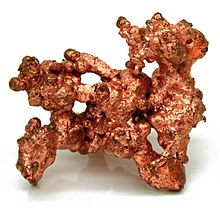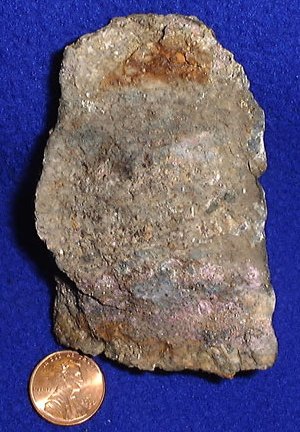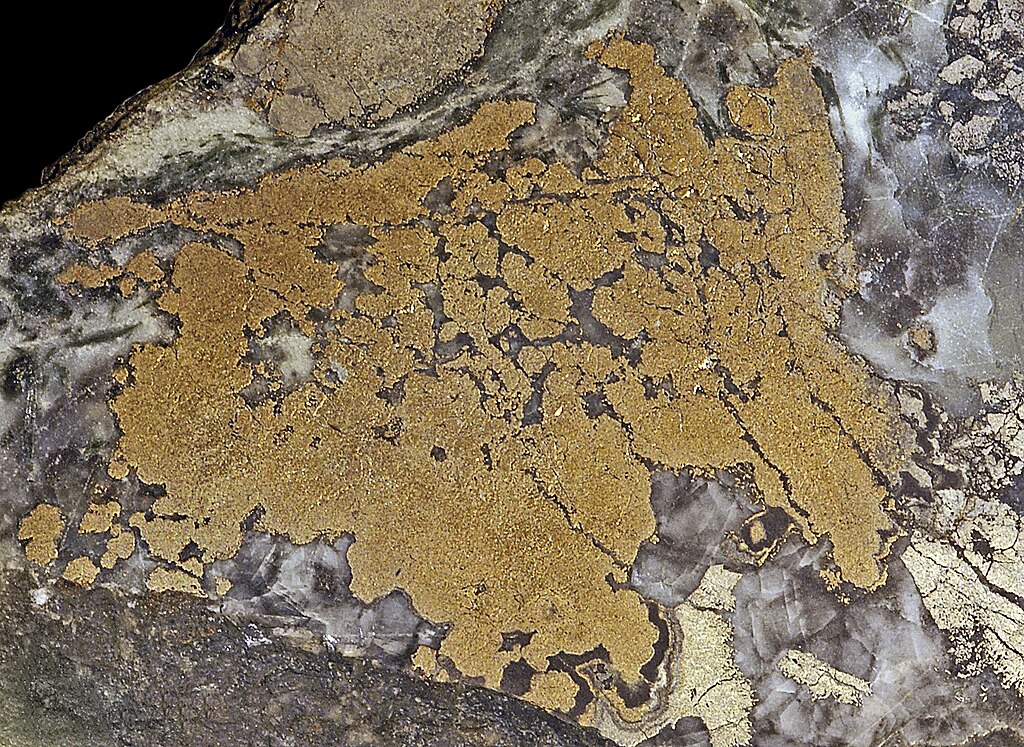Table of Contents
- Copper
- Where to Find Copper in British Columbia
- Where to Find Copper in Yukon
- Where to Find Copper in Manitoba
- Where to Find Copper in Ontario
- Where to Find Copper in Quebec
- Where to Find Copper in New Brunswick
- Where to Find Copper in Nova Scotia
- Nickel and Cobalt
- Where to Find Nickel and Cobalt in Ontario
- Where to Find Nickel in Manitoba
Copper
Copper ores are found in a great variety of formations. Native copper occurs in trap, particularly the amygdaloidal variety; it is deposited in the amygdules and in veinlets and joints. At the surface, the copper may show its presence by the green and blue stains of the carbonates, malachite and azurite.
The neighborhood of intrusive basic rocks is favorable for copper ore deposits, which may be found at or near the contacts as replacement deposits or mineralized zones. Replacement by copper ore takes place more readily in basic than in acid rocks. For example, in places where rhyolite and basalt are in contact, the copper ore will be found in the basalt.
Copper pyrites and bornite contain iron; on weathering, they leave limonite as an insoluble product, of a rusty color. The conspicuous green carbonate, malachite, is another weathering product, and also the less common blue carbonate, azurite. Since the sulphides of copper weather more quickly than iron pyrites, and since all these sulphides are apt to occur together, any rusty capping should be carefully examined, even though at first nothing but iron pyrites is found beneath it; the copper minerals may come in at greater depth. A large, lean copper deposit, which would not pay to work for copper alone, may carry enough gold and silver to make it of value.
No so-called “porphyry copper” has yet been established as a mine in Canada; but the requisite “mountain of ore” might be found at any time. The large, low-grade deposits of Gaspé, Quebec, are the nearest we have to porphyry coppers meantime.
Where to Find Copper in British Columbia
There are numerous deposits of copper ore in British Columbia along both the eastern and the western borders of the great batholith of granitic rocks forming the core of the Coast Range. So far, the greater part of the production has come from the islands and mainland of the west coast, and from the south, where the batholith bends to the east. In Southern British Columbia, important ore bodies have been mined at Phoenix and Deadwood, where high temperature deposits of chalcopyrite and pyrite were found as replacements of limestone. The gangue minerals were actinolite, garnet, epidote, calcite, quartz, etc. Magnetite was characteristic of the Deadwood ore, and specular hematite, of the Phoenix deposit. The Rossland gold-copper ores commenced production in 1894. The ore is a mixture of pyrrhotite and chalcopyrite in a gangue of basic porphyry, which also forms the country rock. The ore is found as fissure-fillings and replacements along shear zones. At Allenby, 13 miles south of Princeton, there are extensive copper ore deposits associated with an intrusion of monzonite ( syenite – diorite ), which breaks through the Paleozoic sedimentary rocks of the area. The Copper Mountain mine has been operated for many years in these deposits, with ore averaging about 1 percent copper. The ore is found partly at the igneous contacts and partly in shear zones. The ore minerals are chalcopyrite, pyrite, pyrrhotite, with some magnetite and mispickel. The gangue minerals are calcite, feldspar, and quartz.
In the Tulameen area, the deposits are mostly of the contact-metamorphic kind, and consist of chalcopyrite, pyrite, pyrrhotite, etc., in metamorphosed limestone; but some of the deposits are fissure-fillings and replacements in shear zones.—On the Pacific Coast, at the Britannia mine, the ore consists of lenses of schist, filled with quartz, pyrite, chalcopyrite, and a little zinc blende. These lenses are in a shear zone at least five miles long and about 500 feet wide. At Anyox, and at Maple Bay, bodies of chalcopyrite, pyrrhotite, etc., either in or closely associated with hornblende schist, were mined successfully. At Drum Lummon mine, on Douglas channel, the chief ore minerals are chalcocite and bornite, found in pegmatite dikes cutting quartz diorite. The Tyee mine, Vancouver Island, consisted of a single huge lens of chalcopyrite, with pyrite, zinc blende, and galena in a gangue of barite, quartz, and calcite. The country rocks are schists. Similar deposits are found at many places on the islands and mainland along the Pacific coast.
Contact-metamorphic deposits in limestone or closely associated with it are found on Vancouver and other islands, and also on the mainland. They consist usually of magnetite mixed with silicates and country rock, the whole impregnated with chalcopyrite, pyrite, bornite, etc. The intruding igneous rocks are mostly of the diorite class. Sometimes there is so little of the sulphides in the bodies of magnetite that the latter can be used as iron ore. This is seen on Texada Island, where the copper ore is found replacing limestone at or near the contacts with the intruding rocks of the diorite kind. The gangue consists largely of the high temperature minerals garnet, epidote, and diopside. The Sunloch mine, on Vancouver Island, is in volcanic rocks cut by a wide gabbro dike. The volcanic rocks are much altered, consist mostly of hornblende, and are schistose near the gabbro. The ore minerals are chalcopyrite and pyrite. They are in veinlets, or disseminated through the schist.
Along the Eastern edge of the Coast Range batholith are deposits of copper ore of the replacement type. South of Hazelton, the ore is found along shear zones, the rock being replaced mostly by chalcopyrite and hornblende; but in places, pyrite, pyrrhotite, mispickel, galena, zinc blende, and tetrahedrite are found. Sometimes the silver and gold values exceed that of copper. At Copper Mountain, Gun Creek, there are deposits of chalcopyrite and pyrite in a shear zone in granodiorite, where it has been intruded by diorite porphyry.
Where to Find Copper in Yukon
The Coast Range batholith of grano-diorite, etc., continues northward into Yukon. Along its eastern edge have been found copper ore deposits of the contact-metamorphic class. In the Whitehorse district, the ore occurs where limestone has been intruded by igneous rocks, varying from gabbro to granite. The ore sometimes consists of magnetite with grains and small bunches of bornite and chalcopyrite. In other cases, the ore minerals are disseminated through a mass of silicates, and in one case, hematite is the gangue mineral. Garnet, augite, and epidote are to be seen in the crystalline limestone near the intrusions.
Where to Find Copper in Manitoba
The Flin Flon deposit in Northern Manitoba north of Lake Athapapuskow, is a very large ore-body in greenstone of volcanic origin. In and near the ore-body, the greenstone is schistose, and the ore has replaced the schisted rock, in part completely, so as to form a solid body of sulphides. Other parts have the sulphides scattered through the schist. The ore minerals are pyrite, zinc blende, and chalcopyrite. Within the ore-body, the country rock is mostly altered to chlorite schist. There are large masses of barren rock within the ore-body; these are not schisted. The process of replacement seems to have followed the schisted rock formed along a great shear zone developed by intrusive granite. The Flin Flon ore averages 1.9% copper, 3.8% zinc, with small amounts of gold and silver. The tonnage is very large. The Mandy Mine, south of Flin Flon, produced about 25,000 tons of rich copper ore averaging about 20% copper. The ore-body is of the replacement kind. Several other deposits of copper ore have been mined in the district including the Sherritt-Gordon, an important deposit about 40 miles north of Flin Flon.
Where to Find Copper in Ontario
The Sudbury area has produced large quantities of copper from its copper-nickel ores. Deep diamond drilling has indicated that these ore-bodies may change at depth into richer copper ores. — In the Parry Sound District, bornite, chalcocite, and copper pyrites are found in disseminated zones in schistose diorite and garnetiferous gneiss.—Copper pyrites and bornite in veins of quartz and dolomite are characteristic of the Bruce Mines District. Bruce Mines has produced a large quantity of copper, and was active as far back as 1846. At Rock Lake and other points north of Bruce Mines, smaller deposits have been mined. The veins are associated with diabase sills and sedimentary rocks similar to those of the Cobalt district.—At Whisky Lake, north of Massey, are deposits of copper pyrites in veins or disseminated zones in diabase and sedimentary rocks of the Huronian age. There are numerous other areas north of Lake Huron where diabase sills intrude rocks of this age. Doubtless careful prospecting there will lead to the discovery of other important deposits of copper ore.—North of Schreiber, near Big Duck Lake, chalcopyrite with pyrite, malachite, azurite, and molybdenite, is found in a quartz vein in hornblende schist. There are intrusions of granite in the vicinity. Further north, the recent discovery of some really large copper deposits at Manitouwadge indicates that there is still good prospecting ground comparatively close to Lake Superior. — In the Shebandowan Lake area, there is a deposit of chalcopyrite with pyrite and pyrrhotite at Round Lake. The ore is found in schist of the Keewatin age, near porphyry dikes. — Near Mine Centre are bodies of chalcopyrite with pyrite and pyrrhotite in mineralized zones in sericite schist. Scattered bunches of chalcopyrite and pyrrhotite have been found in the anorthosite of that area. — In Northeastern Ontario, deposits of copper ore have been found somewhat like those of the Rouyn area in the adjoining part of Quebec. The remarkably rich deposits on Temagami Island being mined by opencut are the first of these to be exploited successfully. — In the Kamiskotia area northwest of Timmins, several discoveries have been made. The deposits are in association with diabase and serpentine of Haileyburian age. — Another interesting discovery has been made in Munro township east of Matheson. The ore is chalcopyrite with bornite, pyrite, pyrrhotite, and zinc blende. This area also is largely underlain with basic rocks of Haileyburian age now more or less changed to serpentine. There are many patches of Haileyburian rocks throughout Northeastern Ontario. They should be carefully prospected for copper.
Where to Find Copper in Quebec
In Southeastern Quebec, copper ore has been mined since 1841. The Capelton, Eustis, and later, the Weedon mines, were worked until 1877 for the copper content alone; but as the ore was essentially pyrite with a small percentage of chalcopyrite, its value as a source of sulphur was recognized. The Eustis was mined to a vertical depth of over 5000 feet. The ore occurs in lenses in sericite and chrorite schist, along anticlines of preCambrian and Cambrian schistose rocks. There are two zones of these schistose rocks, and most of the copper deposits are within or close to these zones: they are replacement deposits. The ore minerals are pyrite and chalcopyrite, with small amounts of zinc blende and galena, and very little pyrrhotite. The ore carries low value in gold and silver. With the aid of modern methods half-a-dozen of the old deposits have been turned into deep mines making a good profit,
In Northwestern Quebec lie the important copper ore deposits of the Rouyn area. The ore bodies are found in Keewatin lavas, and mostly as replacement deposits in basic lava.
Where rhyolite and andesite are in contact, and have been invaded by chalcopyrite and pyrite, the copper mineral is confined to the andesite, a volcanic rock corresponding to the plutonic rock, diorite. The andesite weathers greenish, and the rhyolite light gray. It is important to remember that the important copper ore deposits of this area have been found so far only in the more basic lava, such as the andesite of the Horne mine, and the dalmatianite of the Amulet. The ore is usually a mixture of chalcopyrite and pyrrhotite, with smaller amounts of pyrite and, occasionally, a little zinc blende. The ore-bodies have been found mostly within a few miles of intrusions of grano-diorite, from which they may have had their origin. The usual occurrence of pyrrhotite in the ore has made it possible to prospect with the dipneedle and the magnetometer. The Aldemac mine in Boischatel township was found by this means. The Quemont mine adjoining the Horne mine on the north was, on the other hand, found by straight underground mining.
Where to Find Copper in New Brunswick
Chalcopyrite has been found in schistose rocks in a number of places in Southern New Brunswick. Near Dorchester, chalcocite occurs in nodules and scattered grains in sandstone of Carboniferous age and attempts have been made to mine it.
Where to Find Copper in Nova Scotia
At Cape d’Or, in Cumberland county, native copper occurs in volcanic flows. Chalcocite and malachite have been found in Carboniferous sandstone in places along Northumberland Strait. The Mindamar mine, formerly known as the Stirling, in Southern Cape Breton, produces copper zinc, and lead from “masses of sulphides that occur as replacements along planes of schistosity in volcanic rocks that may be of Precambrian age.”
Nickel and Cobalt
The arsenical ores of nickel and cobalt are referred to under Silver, Art. 262; but it should not be forgotten that some such ores are barren of silver. To be workable for the cobalt, nickel, and arsenic contents, the veins would have to be larger than the great majority of the silver veins of the Cobalt area.
Where to Find Nickel and Cobalt in Ontario
The most plentiful nickel ore at present known is that of the Sudbury area, Ontario. It is a mixture of pyrrhotite and copper pyrites, with smaller quantities of pentlandite (a sulphide of nickel and iron) and polydymite (a sulphide of nickel). The pyrrhotite itself is believed to carry part of the nickel content of the ore, which averages about 3.5 per cent. The ore also carries about 1.5 per cent copper as copper pyrites. In addition to nickel and copper, these ores carry small values in gold, silver, and metals of the platinum family. The ore bodies are found at or near the contact of a great norite mass with granite, etc. The prospector’s guide has been the gossan, or iron cap, left by the easily weathered minerals. Attempts have been made to discover pyrrhotite ore bodies by means of the magnetometer, pyrrhotite being magnetic; but since the magnetic attraction of pyrrhotite varies, and since magnetite may be present in granite and other igneous rocks in sufficient quantity to cause considerable attraction, these attempts have been only partially successful. The large ore body at Levack was found in this way; also the Falconbridge deposit.
As the majority of pyrrhotite deposits outside the Sudbury area do not carry a paying quantity of nickel, an assay should always be made before any newly discovered pyrrhotite is looked upon as nickel ore.—The Alexo nickel ore deposit, in the Timiskaming District, Ontario, is a body of pyrrhotite, carrying 6 to 8 per cent nickel; it is at a contact between pillow lava and serpentine. At several other localities in Northeastern Ontario, nickel has been found in bodies of pyrrhotite, etc., in serpentine. It is possible that other ores, the green silicates, garnierite, genthite, etc., may be found in Ontario in serpentine or peridotite.—South of Lake Shebandowan (West of Lake Superior), important values in nickel are found in a deposit of pyrite, chalcopyrite, pyrrhotite, polydymite and magnetite, in a long mineralized zone of chlorite and serpentine schists, probably altered peridotite. There is an intrusion of granite not far away. Nickel deposits have been found more recently in the northern part of District of Kenora in a somewhat similar association.
Where to Find Nickel in Manitoba
Near Maskwa and Oiseau rivers, there are bodies of pyrrhotite, pentlandite, and chalcopyrite carrying nickel. These occur in a shear zone at the contact of gabbro with Keewatin volcanic schists. The ore contains much ilmenite and magnetite. The important Lynn Lake mine of Sherritt Gordon in the far northern part of the province contains nickel in massive and disseminated sulphides, occurring mainly in gabbro and peridotite.
